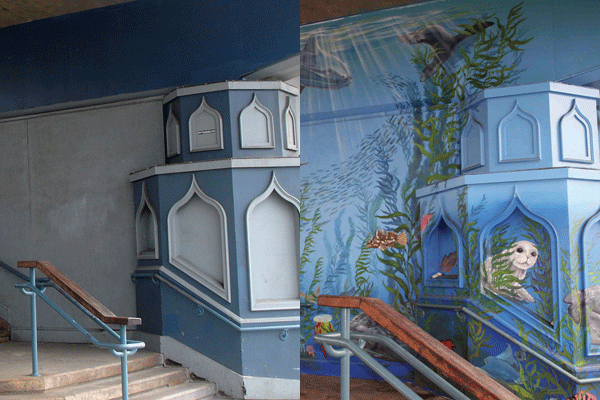Muralist David Legaspi passed away earlier this month, leaving behind a legacy enjoyed by thousands of people each year, the mural outside the Santa Monica Pier Aquarium (SMPA).
David completed the mural appropriately enough in celebration of Earth Day in 2007, which members of the SMPA staff still recall as one of their favorite events in the Aquarium’s history. Under David’s guidance, painting the mural was a community effort, with countless people—from German tourists to a dad and his young daughter, even some high school students—each grabbing a paintbrush to help populate the underwater world he’d created. It was a true community celebration and collaboration — the kind he generated wherever he worked.
Not only did the mural brighten up a dark corner of the pier, it quickly became its own photo opportunity. It seems like a day doesn’t pass when we don’t look out our windows to see someone outside the Aquarium posing for photos in front of it. It’s hard to imagine how many vacation photos, press shots, engagement pictures and recordings of class fieldtrips the mural has provided a backdrop for since its completion.
 Before and After: David Legaspi SMPA Mural
Before and After: David Legaspi SMPA Mural
We first met David when he came to the Aquarium during public hours to research certain rock fish in our tanks for one of his many murals at our local schools. At that time, he and Randi Parent, SMPA’s Outreach Manager, discussed the possibility of David painting an underwater scene outside the Aquarium. With the permission of the Pier Corporation, he launched the full-scale project outside our office windows.
Aquarium visitors are not the only people fortunate to appreciate David’s legacy, as he will live on in the innumerous murals he created around the city and the amount of people whom he has touched along the way. We feel very privileged to have been a part of it all.
Randi Parent recalls: “My last conversation with David was just a few months ago. He was hoping to come back here to complete our underwater scene by painting on the underside of the ramp. He told me how he’d recently been in Australia and a friend showed him her vacation photos taken at the SM Pier. There she was, standing in front of his mural, and she didn’t realize it was his work! He was so pleased with what a small world it is.”
–Randi Parent (SMPA Outreach Manager) and Tara Crow (SMPA Programs Manager)
A Celebration of Life for David is being held June 27, 2012 at 1 p.m. at Barnum Hall on Santa Monica High School campus. For more information, visit the event’s Facebook page.
In lieu of flowers, contributions may be made to: David Legaspi III Memorial Fund, PO Box 2863, Malibu, CA 90265.
Messages can be sent to the family at legaspimemorial@yahoo.com.
View a map of David’s public murals, most of them in Los Angeles area schools.



